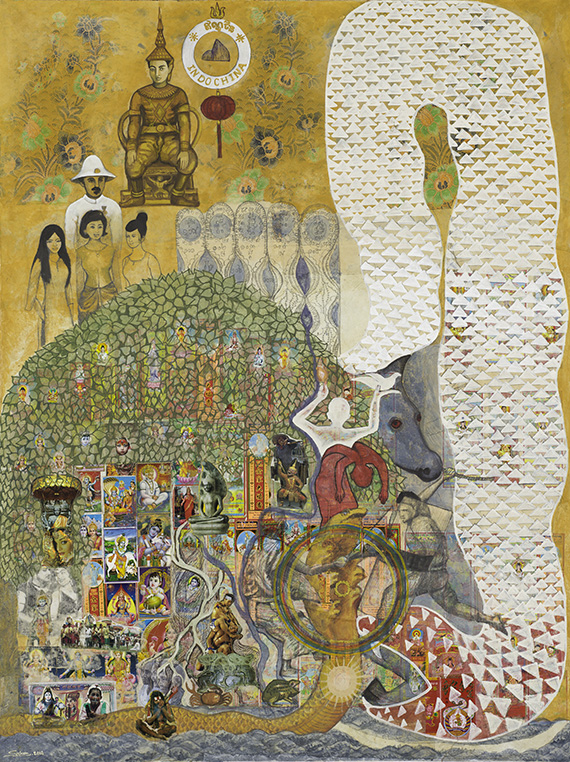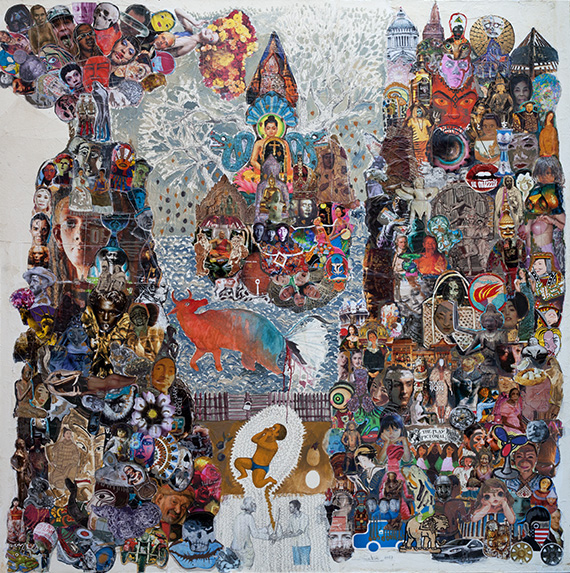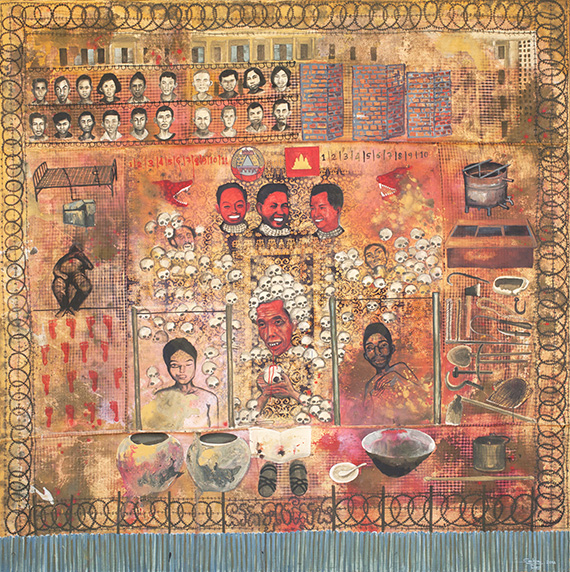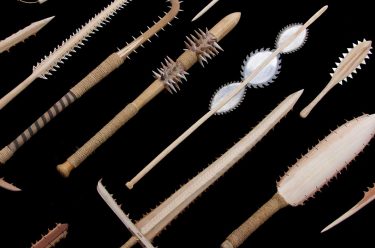
Leang Seckon is one of the few remaining artists in Cambodia who lived through, and directly experienced, the Khmer Rouge period (1975–79). His memories of this time, and his upbringing in the difficult era that followed, continue to be motifs in his works. Leang’s paintings are strongly autobiographical and reflect his experiences of the tumultuous and violent history of modern Cambodia. These works are expressions of spiritual belief, popular culture, and the way a community can address trauma amid rapid social and technological development. Leang’s dense works are characterised by lush tapestry-like surfaces, filled with collaged elements, textiles, stitching, and illustrations that combine myth, history and contemporary media. Hell of Tuol Sleng, Indochina and World born are part of Leang’s most recent body of work entitled ‘Hell on Earth’. Together they represent a key aspect of his practice: placing the everyday visual culture of contemporary Cambodia within a context of ongoing collective healing.

Drawing on a myth about the creation of the Cambodian Khmer Empire, Indochina is dense with imagery representing the history of Cambodia’s kings, warriors, holy men, deities and the mighty Mekong River. Indochina was the name given to the three countries in Southeast Asia under French colonial rule – Cambodia, Vietnam and Laos.
Rich with symbolism, this work interprets a legend in which a dragon princess transforms herself into a woman who lives on the Island of KoTlok. When an Indian prince sails by, following the monsoon winds, they fall in love and create the society that would become the Khmer (Cambodian) Empire. Leang includes both Hindu and Buddhist symbols, as both religions became deeply embedded in Khmer society, alongside Cambodia’s pre-existing belief system. The Mekong River is central to these stories as it is believed to be the mother of life that gave birth to the humans and the naga (the diving dragon or serpent), and remains the symbol of the beginning of Cambodian culture.

In World Born Leang contemplates birth, growth and rebirth underpinned by the anxiety of growing up in a time of war. The centre of the work illustrates a scene from when Leang was very young and staying with his grandmother. It shows an old man he was both scared of and drawn to, thinking it could be the same man his father had spoken of who had appeared in a dream telling him a great son was to be born. Leang remembers the man showing him a knife for fighting the bad people he would encounter throughout life, a knife shown here as a paintbrush. In the centre, Leang recalls witnessing a cow giving birth, which instilled him with fear as he learnt of the birth cycle when he was only a five years old. The collage of sinister faces surrounding this scene represents the constant danger that Leang felt during the war. They are contrasted with the faces of Buddhism that instilled him with great excitement and taught him about death and impermanence. The images on the left combine to form a mountain growing and exploding, representing the natural process of growth and decay, while on the right, ancient culture alongside modern society represent contemporary life.

During the Khmer Rouge period (1975-79), the regime converted a high school in Phnom Penh to a prison, interrogation and extermination site known as S-21 (Security Prison 21), or Tuol Sleng. Today, it is a genocide museum and one of the most confronting reminders of the brutal atrocities of the era. Composed of haunting imagery from the infamous prison, Hell of Tuol Sleng combines Leang’s personal memory with documents, photographs and objects from the site.
Leang recalls being taken to a hospital in 1977 near Tuol Sleng after falling ill and seeing the prison ground. ‘I saw troops wearing black uniforms taking a very skinny person, almost like a ghost, to plough the fields. The person couldn’t even walk, but the soldier hit him and brought ants to bite him. The person fell onto the rice field’. Leang portrays the ghost of a prison guard crowned with skulls below the regime’s three senior figures: Ieng Sary, Pol Pot and Khieu Samphan. Along the top of the painting are illustrations of some of the 6 000 sombre photographs of the victims documented by the prison staff which were uncovered by the Vietnamese Army when the prison was finally abandoned in 1979. Of an estimated 17 to 30 000 people who were taken to the prison, there are only 12 known survivors.
Subscribe to QAGOMA YouTube to be the first to go behind-the-scenes / Watch or Read more about Asia Pacific artists
Feature image detail: Leang Seckon Indochina 2014
#LeangSeckon #QAGOMA

